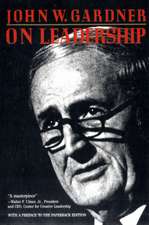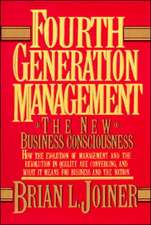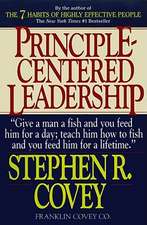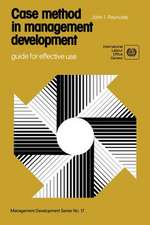Are We There Yet?: Insights on How to Lead by Design
Autor Sam Bucoloen Limba Engleză Paperback – 24 ian 2016
Are our efforts to innovate aligned to the challenges of our times? We face high costs, global competition, low productivity, and technology disruptions. We have relied on massive technology investments, but our growth is declining. If we want to maintain our standard of living, we need firms to grow.
Preț: 89.51 lei
Preț vechi: 109.53 lei
-18% Nou
Puncte Express: 134
Preț estimativ în valută:
17.13€ • 17.88$ • 14.18£
17.13€ • 17.88$ • 14.18£
Carte disponibilă
Livrare economică 14-28 martie
Preluare comenzi: 021 569.72.76
Specificații
ISBN-13: 9789063694098
ISBN-10: 9063694091
Pagini: 216
Ilustrații: Two-color art throughout
Dimensiuni: 141 x 216 x 20 mm
Greutate: 0.41 kg
Editura: Bis Publishers
ISBN-10: 9063694091
Pagini: 216
Ilustrații: Two-color art throughout
Dimensiuni: 141 x 216 x 20 mm
Greutate: 0.41 kg
Editura: Bis Publishers
Cuprins
INTRO
Foreword
Starting the Conversation with Sam Bucolo
What is Design Led Innovation?
Who is Sam Bucolo?
Acknowledgements
01 Can you tell me how innovative you are?
02 This should be sent to the design and marketing department.
03 I don’t think this way, therefore my staff don’t think this way.
04 Okay, you've got my interest... Where do I start?
05 What does success look like?
06 Every journey needs support.
07 Some final words before you start your journey.
END Chapter Notes
Contacting Sam
Notă biografică
Sam is a leading academic and practitioner in the emerging field of design led innovation, and has led projects which have transformed businesses by embedding design capability. As Professor of Design and Innovation at the University of Technology Sydney, he leads a team investigating the value of Design Led Innovation to the Australian Economy. Sam also is also the convenor of the recently established Australian Design Integration network and is an executive board member of the Cumulus global network.
Extras
what does success look like?
So far, I’ve discussed the elements of DLI, the long journey a CEO must commit to when they embark on transforming their business to lead by design and some of the pitfalls they will likely encounter along the way. It may seem hard, very hard, but the effort in making this shift does pay off. As shown through the stories I’ve presented, the results are reflected in a stronger economic position for the firm, but often and more importantly the creation of a workplace where all staff are aligned around a common purpose, which lifts the culture and productivity of the organisation.
Given this is often such a long journey, it’s easy to get lost in navigating a pathway to success. So what does the destination look like and how do we know if we have arrived?
I hope I’ve communicated that leading by design isn’t a destination, but a complete renewal of a firm’s culture and mindset, which in turn changes how and what it innovates. Once you have developed a solid understanding of your future, it’s a process of continual renewal to ensure your business stays relevant and resilient in dynamically changing markets and customer demands. So there’s no end point … a company doesn’t stop leading by design.
This answer is generally not what CEOs want to hear, particularity in the early stages of their journeys. Therefore, to help firms better understand what ‘success’ or ‘good’ looks like, I’ve developed a framework, which describes the key activities that describe what leading by design is. The framework is the result of my own work with firms, and studying successful design led companies. I had the opportunity to fine-tune the framework while working with a colleague, Peter King, on a report we were commissioned to write for the Australian Federal Government¹ to assist firms to better understand what is meant by leading by design.
The report was based on interviewing high performing, globally competitive, Australian manufacturing firms. These firms use design in its broadest sense to create and capture value. They were found to be purposeful and methodical in their application of design principles to all aspects of their organisation. They use up to date production techniques. Their highly skilled professionals and tradespeople work in modern surroundings and are led by innovative managers.
The key output of this report was the development of a Design Led Innovation framework, which articulates three key underpinnings of what it takes to lead by design: Innovation Focus, Innovation Activities and Innovation Mindset. The goal was to use this to help firms consider what the destination may look like and gauge where they are in terms of their journey.
Innovation Focus , the inner circle, is the major shift a firm needs to undertake – the shift from product focus to business model innovation focus (these points were brought up in chapter 1 and 2).
Innovation Mindset, the outer ring, describes the need to adopt a new approach to framing problems and understanding the customer within the business (this was raised in chapter 3). As previously discussed, realizing a different approach to innovation is needed and adopting a new mindset, is not enough; these must be applied to all activities within a business, which essentially means a redesign of the organisation.
Our studies show that it is the Innovation Activities organisations adopted, combined with the shift in mindset and focus, that is core to the success of these companies.
This chapter will expand on what these activities are and why they’re important. As you will see these five core Innovation Activities aren’t new or novel by themselves. When they’re integrated in an overall business context, they enable companies to strategically maximize their opportunities to create and capture value. This, of course, leads to gaining a competitive edge.
I've drawn out quotes from this report to reinforce these key activities, which you'll see on the following pages. I caution CEOs not to cherry-pick the principles. Alone, they won’t work. They need to be used together, in varying degrees, depending on the organisation they’re being applied to. This creates a dynamic and exciting environment that will prove challenging – but rewarding - not just in terms of a company’s growth, but the engagement and satisfaction of its staff.
In my experience, companies on the DLI journey demonstrate excellence in each of the five key innovation activities, while being clear on their innovation focus and mindset.
Textul de pe ultima copertă
“THE AUTHOR, SAM BUCOLO IS A MAN DRIVEN BY A SINGULAR VISION - THAT DESIGN LED SMES WILL FUEL A NATION’S FUTURE PROSPERITY – A VISION I WHOLEHEARTEDLY ENDORSE ALONG WITH THIS BOOK."
Maureen Thurston, Chair of Good Design Australia
"THE STRENGTH OF THE BOOK, APART FROM ITS PRACTICAL APPROACH WITH MANY CASE EXAMPLES, IS THAT IT CONVEYS AN UNDERSTANDING THAT TO BE SUCCESSFUL IN DESIGN LED INNOVATION THE FIRM MUST NOT ONLY ACHIEVE A DEEP CUSTOMER UNDERSTANDING BUT MUST ALSO CHANGE ITS MANAGERIAL MINDSET AND ENSURE ALIGNMENT OF ALL ITS PROCESSES AND SYSTEMS TO ACHIEVE THE DESIRED OUTCOME."
Göran Roos, Prof. Strategic Management, University of Adelaide
SAM’S BOOK CLEARLY AND SUCCESSFULLY OUTLINES THE ROLE DESIGN CAN PLAY IN DRIVING INNOVATION, HELPING SMES TO THRIVE IN A RAPIDLY CHANGING WORLD.
John Mathers, CEO, Design Council, UK
Maureen Thurston, Chair of Good Design Australia
"THE STRENGTH OF THE BOOK, APART FROM ITS PRACTICAL APPROACH WITH MANY CASE EXAMPLES, IS THAT IT CONVEYS AN UNDERSTANDING THAT TO BE SUCCESSFUL IN DESIGN LED INNOVATION THE FIRM MUST NOT ONLY ACHIEVE A DEEP CUSTOMER UNDERSTANDING BUT MUST ALSO CHANGE ITS MANAGERIAL MINDSET AND ENSURE ALIGNMENT OF ALL ITS PROCESSES AND SYSTEMS TO ACHIEVE THE DESIRED OUTCOME."
Göran Roos, Prof. Strategic Management, University of Adelaide
SAM’S BOOK CLEARLY AND SUCCESSFULLY OUTLINES THE ROLE DESIGN CAN PLAY IN DRIVING INNOVATION, HELPING SMES TO THRIVE IN A RAPIDLY CHANGING WORLD.
John Mathers, CEO, Design Council, UK
Descriere
Are our innovation efforts aligned to the challenges of our times? We need firms to grow.



















